Total Solar Eclipse
2027 August 2

Overview
The 2027 lunar shadow first greets the Earth over the sub-tropical mid Atlantic in a region of moderately cloudy skies well to the north of the hurricane-breeding zone off western Africa. The umbral path misses the islands of Porto Santo and Madeira by a meagre 70 km on its eastward trek, choosing instead to make landfall in Spain and Morocco six minutes later. For the next 4,000 km, it skips along the Mediterranean shore, gradually turning to a southeast heading. The turn to more southerly latitudes comes with increasing amounts of cloud, but, except in the mountains of Arabia, most of that intrudes after the path heads out across the Indian Ocean, toward its ending near the remote atoll of Diego Garcia.
Few eclipses come with a guarantee of cloud-free skies, but, in parts, the path of the 2027 total across North Africa comes very close (Figure 1). A large part of the eclipse track skirts the north side of the Sahara Desert and August climatology along the shadow path borrows its character from that great sand sea. It’s hot, it’s dry, it’s sunny, and it’s dusty.
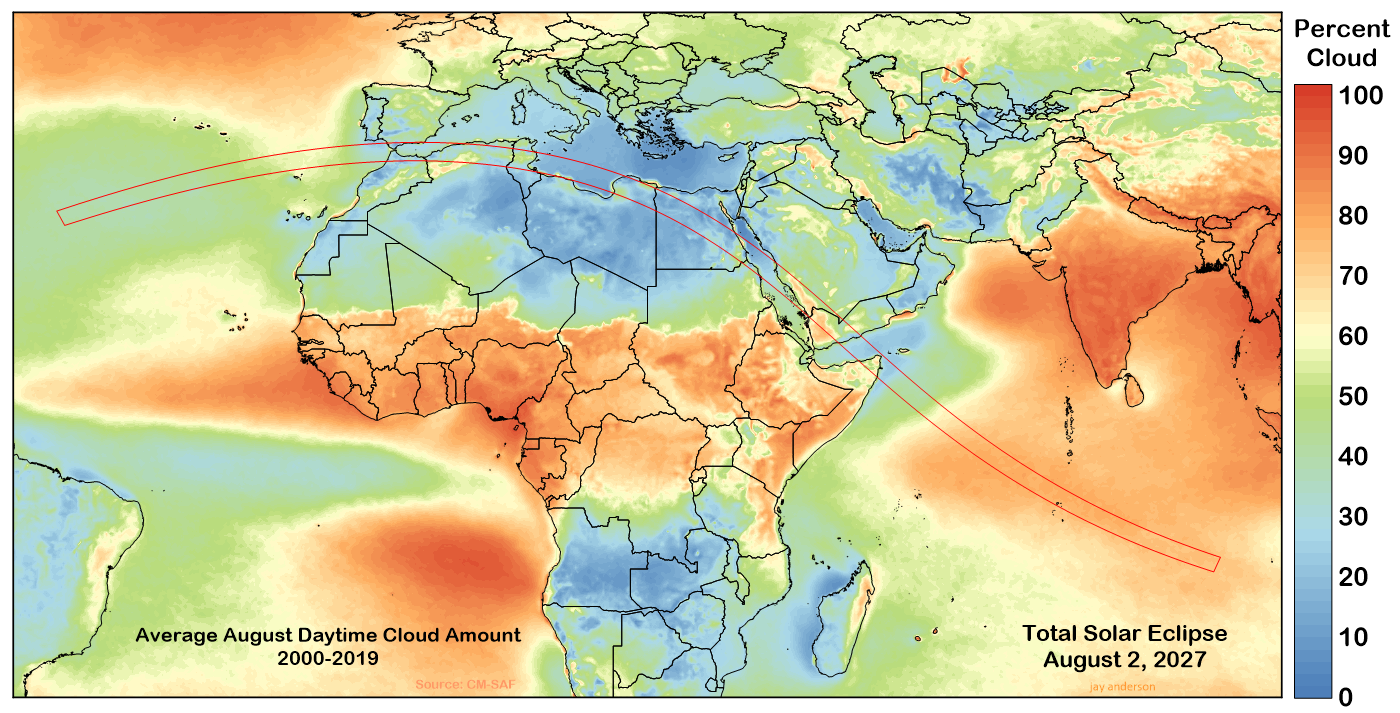
An eclipse thrives on that kind of climatology. Some parts of the eclipse track—over Libya and western Egypt—have seen no August cloud on eclipse day whatsoever in the past 23 years. And even though Spain and Northwest Africa have their cloudy days, but it’s not common and eclipse-day chances are still among the best.
Most of this good weather comes courtesy of the Azores (or Bermuda) high over the mid-Atlantic that extends a ridge of higher pressures along the track. It’s not until the shadow reaches Egypt that the anticyclone gives way to lower pressures, but these are lows generated by the heating of the land and don’t share the cloud-making character of their more traditional counterparts. Instead, cloud along the track usually follows the wind flow: winds off of the land tend to bring dry weather, while flows of off the Mediterranean or the Red Sea bring clouds. High-level winds bring larger weather systems with larger cloud shields. When terrain is added to the mix, high elevations are where clouds go when all else is dry. After the shadow leaves the African continent for the Arabian Peninsula, sunshine prospects begin to weaken, but even here there are clear-sky refuges that will tempt the most fastidious eclipse chaser.
Figure 4’s graph, which shows the satellite-derived cloud cover along the centerline and the north and south limits, provides a more detailed look at cloud cover along the track. In some cases, eclipse travellers will be better off to deviate off of the centerline to the north or south to take advantage of better cloud prospects.
Spain, Gibraltar and Morocco
This total eclipse is the first of two in this small part of the world; an annular eclipse will follow in just five months, in January 2028. For this 2027 event, the umbral shadow passes primarily over the Alboran Sea (Figure 2), but along the way, touches coastal Andalusia, the autonomous Spanish cities of Ceuta and Melila in North Africa, northern Morocco, and the British territory of Gibraltar.
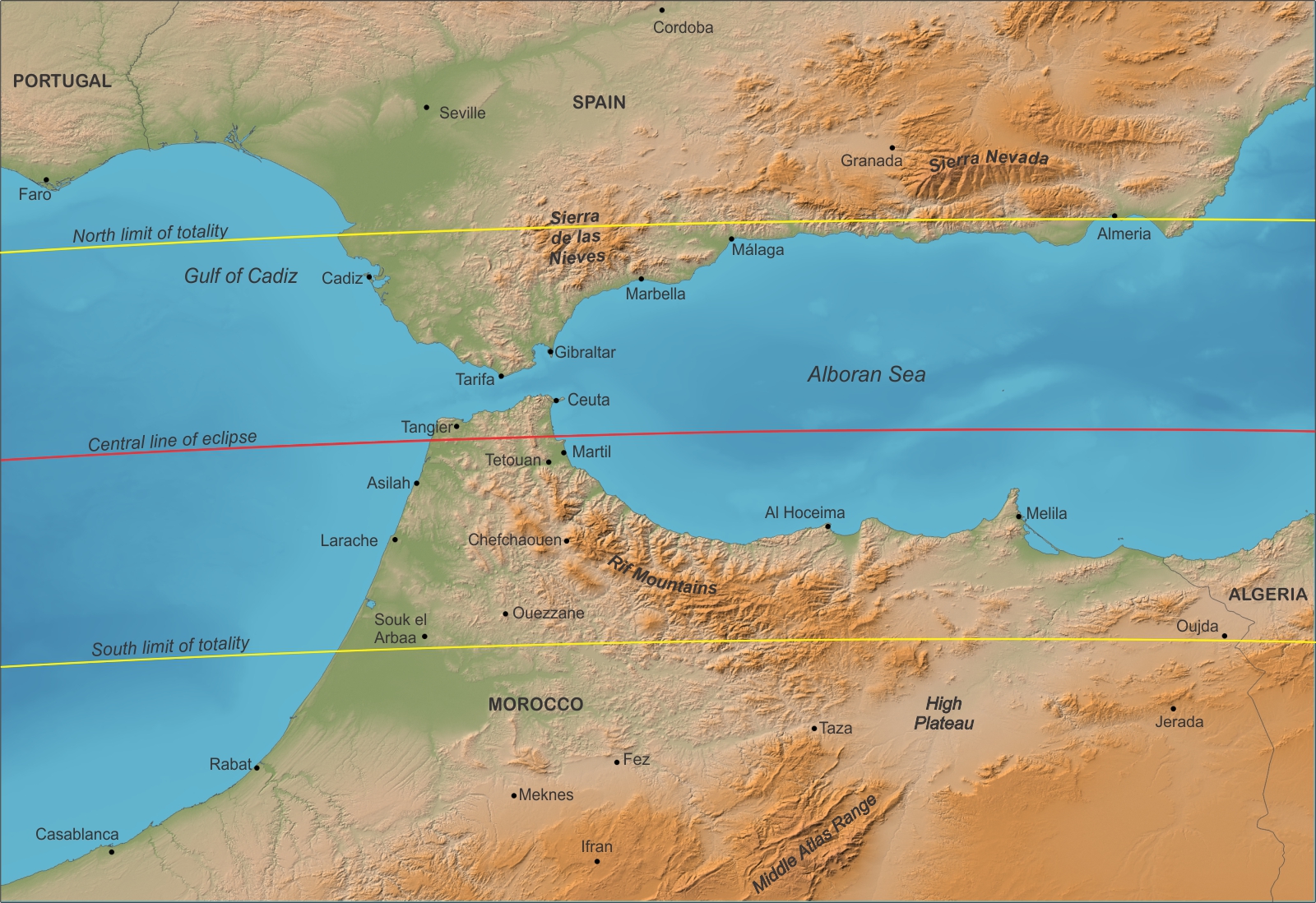
The region has a dry sub-tropical climate moderated by the influences of a cold Atlantic Ocean and a warm Mediterranean Sea alongside a rough mountain terrain that abuts the Mediterranean coast. Even tiny Gibraltar has its 426-metre “Rock” to loom over the entrance to the Strait. Wind is an important component of the weather in this area, almost exclusively blowing from either the east (Levanter) or the west (Poniente) across the Alboran Sea and the Gulf of Cadiz. The Levanter (Levante in Spanish) tends to be the more persistent, sometimes blowing steadily for days and even weeks, particularly in the summer months. The two winds make the Strait and the Gulf of Cadiz prime spots for kite boarding and wind surfing.

In Figure 3, a map of cloud fraction (or percent monthly cloud if multiplied) derived from two decades of satellite observation shows that the waters of the Alboran Sea and the Strait of Gibraltar are cloudier than any other region along the African portion of the track. Fed by inflowing Atlantic currents, the cool surface waters of the Alboran Sea create a stable, surface-based temperature inversion during a Levanter. Air beneath the inversion often (but not always) turns to fog, stratus, and haze as it is cooled from below. This low cloud is thickest in the morning and evening, but seldom penetrates more than a few kilometres inland and usually much less. In the summer months, the Levanter is generally a moderate breeze and its impact on the weather is muted. Because much of the Strait cloudiness forms at a low level in the atmosphere, it is quick to erode as temperatures rise during the day, though that may be too late for an eclipse that occurs at mid-morning.
More detail about the cloud climatology is provided in the graph of cloudiness along the centerline and both limits (Figure 4). In this graph, you can determine the value of going off of the centre line in search of a better climatology. Land-based sites are significantly more promising than those over or near water (compare the overwater centreline between Ceuta and Oran with terrestrial paths of both the north and south limits). High terrain also provides less favourable weather prospects: Cloud cover climbs about 8 percent as the south limit crosses the Rif Mountains in Morocco, and nearly 14 percent on the south limit across the Tel Atlas Range between Sebdou and Djelfa in Algeria.

In Gibraltar, the Levanter is responsible for a streaming flag of cloudiness that frequently flies from the upper slopes of the Rock of Gibraltar, typically when the wind blows between 15 and 40 km/h. This monolithic limestone rock lifts the Levanter wind and condenses its moisture into a long, flowing cloud banner that stretches downwind from the peak. The size and persistence of this iconic banner depends on the strength of the wind, the amount and depth of the moisture, and the stability of the air and can take on many engaging forms, all hanging unmoving from the peak. Eclipse observers should pay close attention to the wind forecast and position themselves off to the side of the peak if the Levanter is active but it could also present an attractive photo opportunity. The eclipse lies in an easterly direction (095°) at relatively low altitude (38°) from Gibraltar. Because the banner is stationary, it is easily avoided or, if you want, engaged.

The opposing wind, the Poniente, is a dry westerly or northwesterly wind that brings good visibility in the summer months – enough to see the coast of Africa from Tarifa. It’s not as frequent as the Levanter and generally a bit weaker. Outside the Strait, at Cádiz, the Poniente is a cool and humid flow that moderates the high temperatures of summer. East or west wind, cloud cover is very low across inland Spain during the summer dry season, averaging 15-20 percent everywhere beneath the shadow path between Cadiz and Málaga. Rainfall amounts to only a few millimetres in August (Table 1).
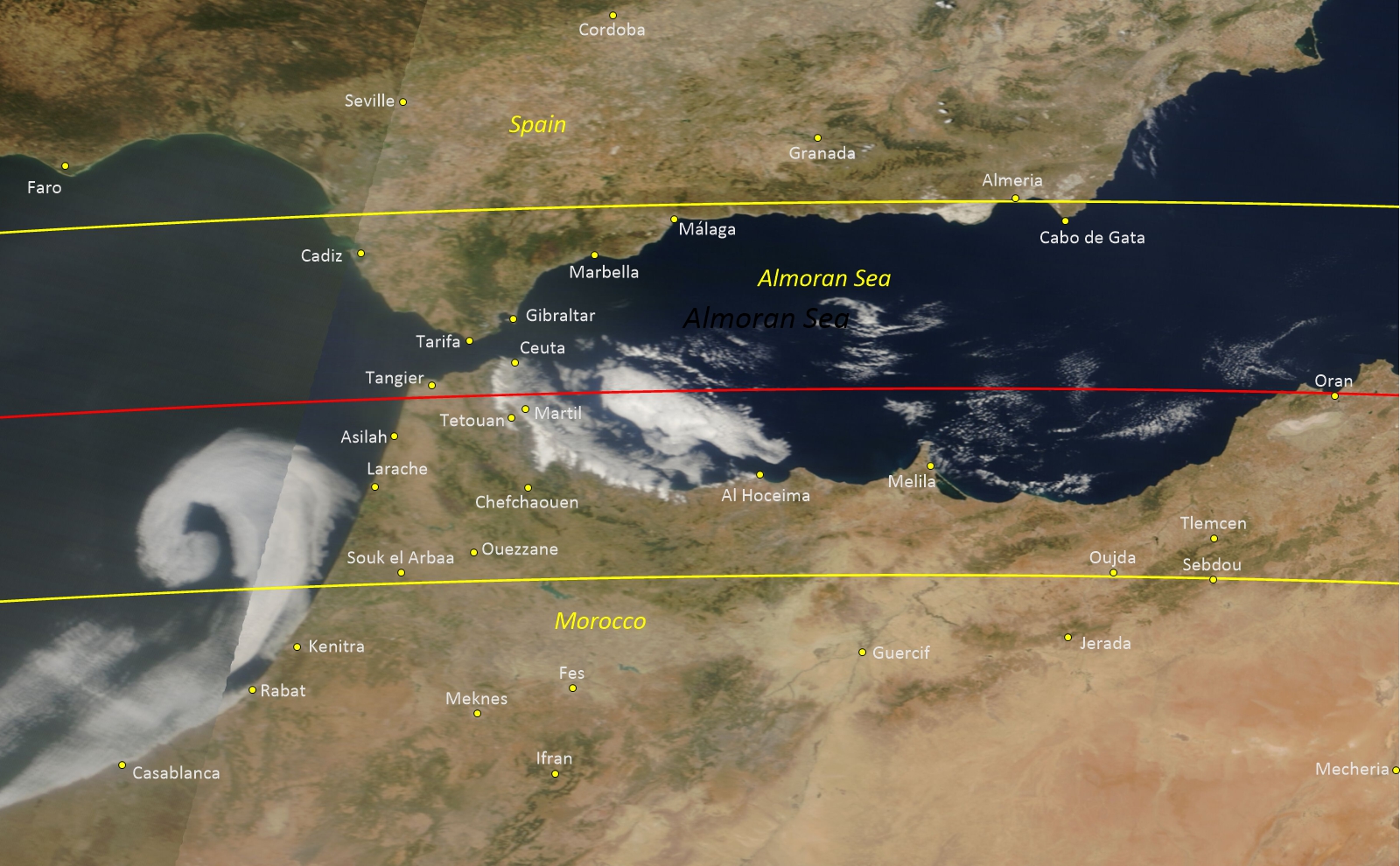
Topography along both coasts of the Alboran Sea also has a significant regional influence on cloudiness. The western end of the Alboran Sea is constrained by the Sierra de las Nieves on the Spanish side and by the Rif Mountains of Morocco on the south. While the terrain on the Spanish side has only a small influence on cloudiness, that on the Moroccan side has a dramatic impact. The coastline of Morocco forms a scooped or basin shape, capturing the easterly Levanter as it impacts the coast (Figure 5). The stratus cloud and the rare weather systems that move over the Alboran Sea occasionally pack up against this coast, pressing cloud against the Rif Mountains, which the cloud is unable to cross. The average August cloud amount reaches nearly 50 percent east of Ceuta in Figure 3. Sunshine observations at Melila average only 61 percent of the maximum possible, well below the 75 to 80 percent at many other locations along the track (Table 1).
Cloud piles up against the Rif Mountains impacts the cities of Ceuta, Martil, and Tetouan, significantly reducinf the frequency of sunny hours at Melila and Al Hoceima in Table 1. In Spain, the terrain is most likely to produce convective cloud in the afternoon, sometimes in concert with weak summer cold fronts that sweep across the region and extend into inland Africa.
On the Atlantic side of the Strait, and along the ocean-facing coasts of Spain and Morocco, cloud cover changes its character. The flow out of the Strait sometimes creates a “streamer” of cloud that may turn and hug the coast for a short distance to the north or south, but these are uncommon. More frequently, marine clouds or fog moves onto the Atlantic coast of Morocco, though it doesn’t penetrate far inland. Morning convective clouds buildups are common on the mountains and may turn into severe thunderstorms in the afternoon, but this should not be a major problem in the morning when the shadow passes.
In spite of the impact of terrain and water, most cloudiness that affects North Africa is not local in origin. There is a moderate amount of mid and high-level cloud that arrives with weather systems that are familiar to Europeans and North Americans. Cold fronts from the Atlantic and Spain occasionally sweep southward across the eclipse track bringing bands of broken cloud from Morocco to Tunisia. The sub-tropical jet stream usually lies across Spain in August, but often dips southward to carry mid- and high-level cloud through the region. Saharan lows bring hot, dusty weather northward while small Mediterranean lows spread cloud and precipitation along the coasts and onto the shadow path. Thunderstorms frequently form on the mountains on either coast and spread cirrus and mid-level cloud downwind though, fortunately, are creatures of the afternoon and the eclipse is in the morning. Overall, however, such systems are infrequent and sunny weather dominates.
Most of these larger weather systems will affect the early part of the eclipse track, from Tangier to Sfax, after which the coastline dips sharply southward and the track turns to the southeast, away from the temperate-zone storms and into the desert climatology.
Algeria, and Tunisia
Algeria’s climate is strongly influenced by topography, particularly the Tell Atlas mountain range that runs parallel to the Mediterranean coast (Figure 6). To the south of these coastal mountains lies a dry highland plateau, the Hautes Plaines (High Plateau), ranging in elevation from 400 m in the east to over 1000 m in the west. Still farther inland lies a second parallel chain of mountains, the Saharan Atlas Range, higher than the Tell Atlas range and defining the northern boundary of the Sahara Desert. The coastal range creates a rain shadow on its southern side, blocking moisture that would arrive with westerly and northerly winds from moving into the plateau and the Sahara Desert. The Hautes Plaines, while dry enough to be described as a part of the Sahara, are home to numerous salt lakes and salt pans. The Sahara Desert itself is located on the south side of the Sahara Atlas Range and intrudes onto the eclipse track in eastern Algeria and southern Tunisia.

The north limit of the eclipse track generally lies along the coastal plain (Tell) as far as Constantine where it encounters the Tebessa Mountains along the Tunisian border. The centre line samples all of the regions—the Tell, the Tell Atlas Range, and the Hautes Plaines; the south limit traverses the Hautes Plaines and the Sahara Desert into Tunisia. The impact on cloudiness of these three regions can be teased out of Figures 3 and 4, where it can be seen that the Tell gives the north limit a higher average cloudiness than either the high plains or the desert, as might be expected. Another prominent terrain impact can be seen over the Aurès Mountains on the centreline, which occasionally blossoms with afternoon convective clouds.
As in Morocco and Spain, wind is a major feature of the North African climate, particularly for its role in bringing dust and sand storms. Prominent among the various types is the sirocco, a south or southeast wind in advance of a low pressure system coming from the west. As a south wind, it has many aliases along the eclipse track—ghibli, khamsin, harmattan, chibli, haboob, and simoom—though not all are born of the same conditions. In Algeria and Tunisia, it is a hot and dry wind from the Sahara; after crossing the Mediterranean and reaching Europe, it’s much more humid.
The desert climatology of much of the eclipse track makes for dry summer weather but on some parts of the track, the proximity of the Mediterranean and its ready moisture supply makes for a wetter August than at locations farther inland. Cold fronts can sweep across the Mediterranean and bring wet days when they run up against the Tell Atlas Range. Small, rare, but occasionally intense Mediterranean lows called Medicanes can also spread heavy precipitation inland against the mountains, but these are rare in August and most often affect the European side of the Mediterranean. More frequent are days with thunderstorms. These form on the Tell Atlas Range when an upper disturbance moves into the area and can bring flash flooding. These seem to be rare in August, when the dry season is at its height but storms of lesser intensity can occur throughout the year.

In Tunisia, the eclipse track descends from the Tebessa Mountains onto the smoother terrain along the Mediterranean coast. Cloud cover is high until the track passes Firyanah and then drops sharply as the influence of the Sahara is felt; the track is no longer protected from the desert by a chain of mountains. This fortunate topography gives Sfax and the region to its south the lowest average cloud amount along the western part of the track.
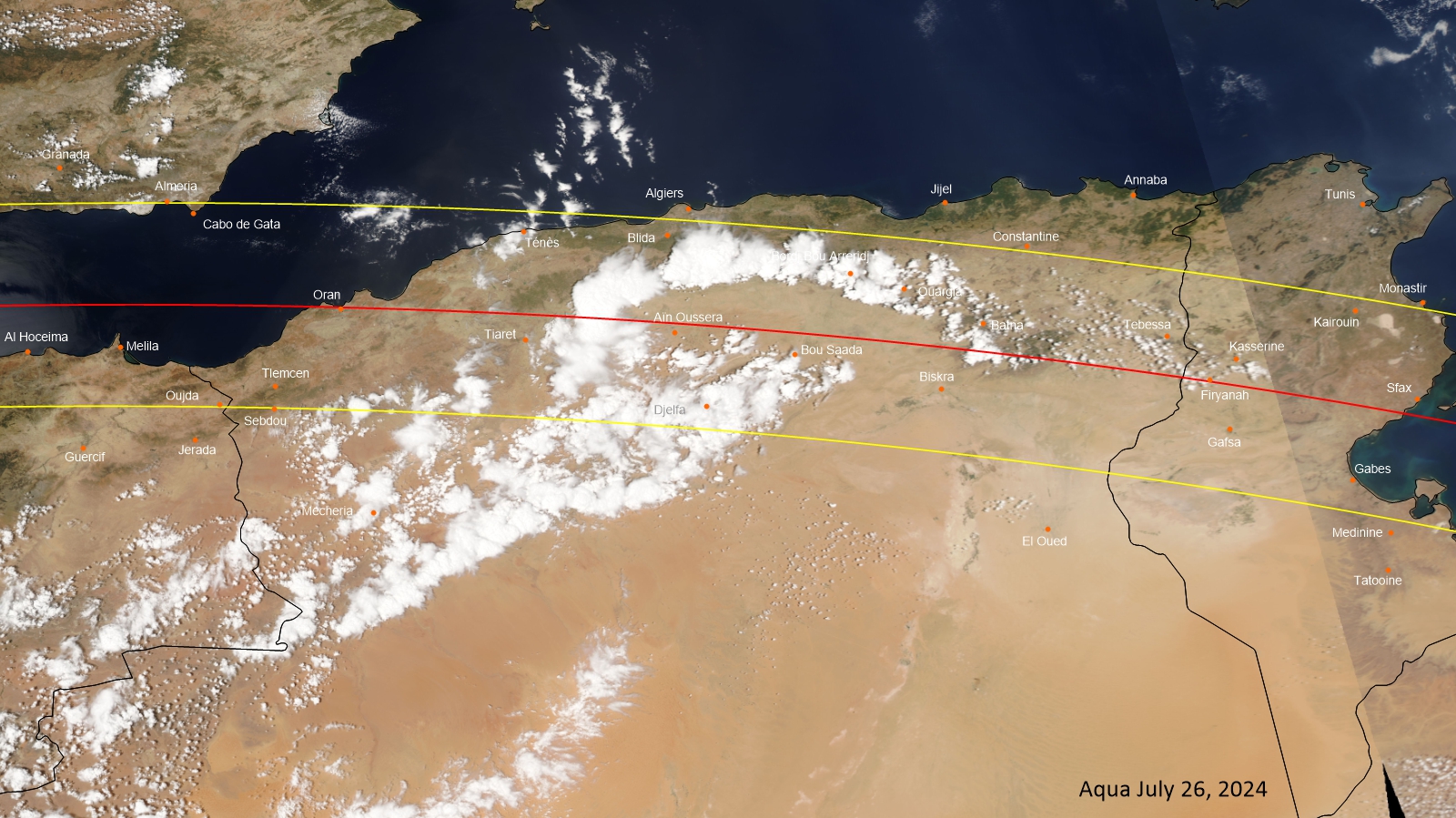
Dust and sand storms
One cannot have an eclipse along and over the world’s biggest desert without having to contend with dust and dust storms. Figure 8 shows the 10-year mean August aerosol optical depth (AOD) over North Africa, a measure of the extinction of light by dust and haze. Some of this, particularly in Spain, is due to forest fire smoke, but along the eclipse track, it’s entirely due to dust. Values of 0.4 would correspond to a hazy atmosphere; in the U.S., the average value is between 0.1 and 0.15. A value of 1.0 would obscure the Sun. None of the average AOD’s in Figure 8 reach as high as 1.0.
Examination of daily August satellite images of North Africa show many dust-shrouded scenes and a search for historical newspaper reports of dust storms will bring up a selection of ominous pictures and stories from the newspapers. No region anywhere along the track is immune, Spain or Africa, but some areas are more susceptible, usually based on the proximity to a source region. A serious dust storm will not only make a view of the Sun impossible, but also send you into shelter.

The potential impact of atmospheric dust on the eclipse is difficult to evaluate. Figure 8 gives a convenient climatological measure, but reports of serious visibility reductions in the weather station reports are difficult to find, even when the dates are known. In Figure 9, I show the results of an examination of the daily satellite photos and an estimate of the visual appearance of the dust in those images, but it’s entirely subjective and a very rough estimate at best. It serves to show the relative frequency of dusty weather at several stations along the track. Light dust concentrations are difficult to detect against a desert landscape, so inland stations probably appear better than they really are in the graph.
Dust and sand storms are commonly initiated by the cold outflows from afternoon thunderstorms (a haboob) or from the morning breakdown and surfacing of a low-level jetstream flow. The rising dust is then captured by the wind and carried off, sometime for thousands of kilometres. On the eclipse track, the dust-laden southerly wind is known as a Sirocco, though this is the European name and it has several others in the local dialects of North Africa. The dust concentration of a particular storm depends in part on the distance from the source region, which in turn vary considerably in size.

There are several source regions along path. The largest and nearest is the Great Eastern Erg near the Tunisian border in Algeria though there are much larger source regions in Mali and Mauritania to the south that can also send dust onto the track. Eclipse sites such as Djelfa on the south side of the Saharan Atlas Range are most likely to be affected by the heaviest storms from the Erg. There are small local source regions at other locations along the track, mostly large, shallow salt flats. Some of these are found on the Haute Plaine in Algeria; another lies to the south of Tangier in Morocco.
In Figure 8, the average AOD is less than 0.15 over Spain and over Morocco, it lies between 0.15 and 0.20 along the early part of the Moon’s shadow path but rises to about 0.3 over Algeria, particularly near Borg Bu Arreridj. Interestingly, the AOD at Sfax is very low despite the proximity of the desert, falling below 0.15 along the coast but the station graph in Figure 9 shows a moderately high frequency of dusty days. The largest part of these are light-dust days in the satellite images. Since the AODs are monthly averages and on most days there’s little dust at all, the average must come from a few significant events with higher dust loads.
Dust is strictly a function of wind speed and direction, and so is relatively easy to forecast. You can obtain 72 hour forecasts of aerosol optical depth and other products from the Barcelona Regional Dust Center or from Meteoblue.com . Among the offerings at the Barcelona Center is one called “Extinction,” which is a measure of horizontal visibility at the surface. This may not be as useful as the AOD, since the eclipse is not being viewed along the ground, but it may give a better impression of the low-level intensity of a dust storm. There are several other products at the Barcelona center that will allow you to explore the dust threat more fully, but local movement to avoid a plume from the Sahara is not likely to be successful, since atmospheric dust tends to cover large areas.
I’ve probably gone into way too much detail on this assessment, but keep the overall picture in mind. There are few really poor eclipse-site choices along the Northwest Africa part of track. Cloud along the land-based part of the track seldom exceeds 30 percent—a value that is exceptionally favourable given the experience of past eclipses.
Temperature
Temperature tends to take a back seat to cloud when it comes to evaluating an eclipse site, but in this eclipse, you and your equipment will have to be prepared for afternoon highs that top the mid-40s and may even reach to 50°C (110 – 120°F). At Luxor, the average high on August 2 over the past 17 years was 42.0°C and there was very little spread from one year to the next. The highest temperature was 46°C.
Modern cameras usually warn of excessive temperatures—usually around 45°C—inside the body and may shut down, especially when shooting video. Canon warns that very high temperatures (and your camera will be warmer than the ambient temperature) may degrade the quality of still images and suggests some ways of mitigating the effect. You can find several discussions of the problem online, but a simple damp white cloth to drape over your camera could be your best friend. Take a look at Tables 1-3 and plan for the expected temperatures. In any event, a sharp drop in temperature will become noticeable about half-way between first and second contact and the problem will likely end.
But don’t forget yourself. Heat stroke is not compatible with solar eclipses. Take the usual precautions, but don’t rely on them. A buddy system with someone to watch you (and you them) may pay dividends.
Libya and Egypt
From Benghazi to the Red Sea at Berenice Troglodytica, the eclipse track traverses the Libyan and Egyptian Deserts (Figure 10) during one of the hottest months of the year. It’s a fascinating region with a well-developed tourist infrastructure. For the eclipse chaser, cloud cover—or the absence of cloud— doesn’t get much better.
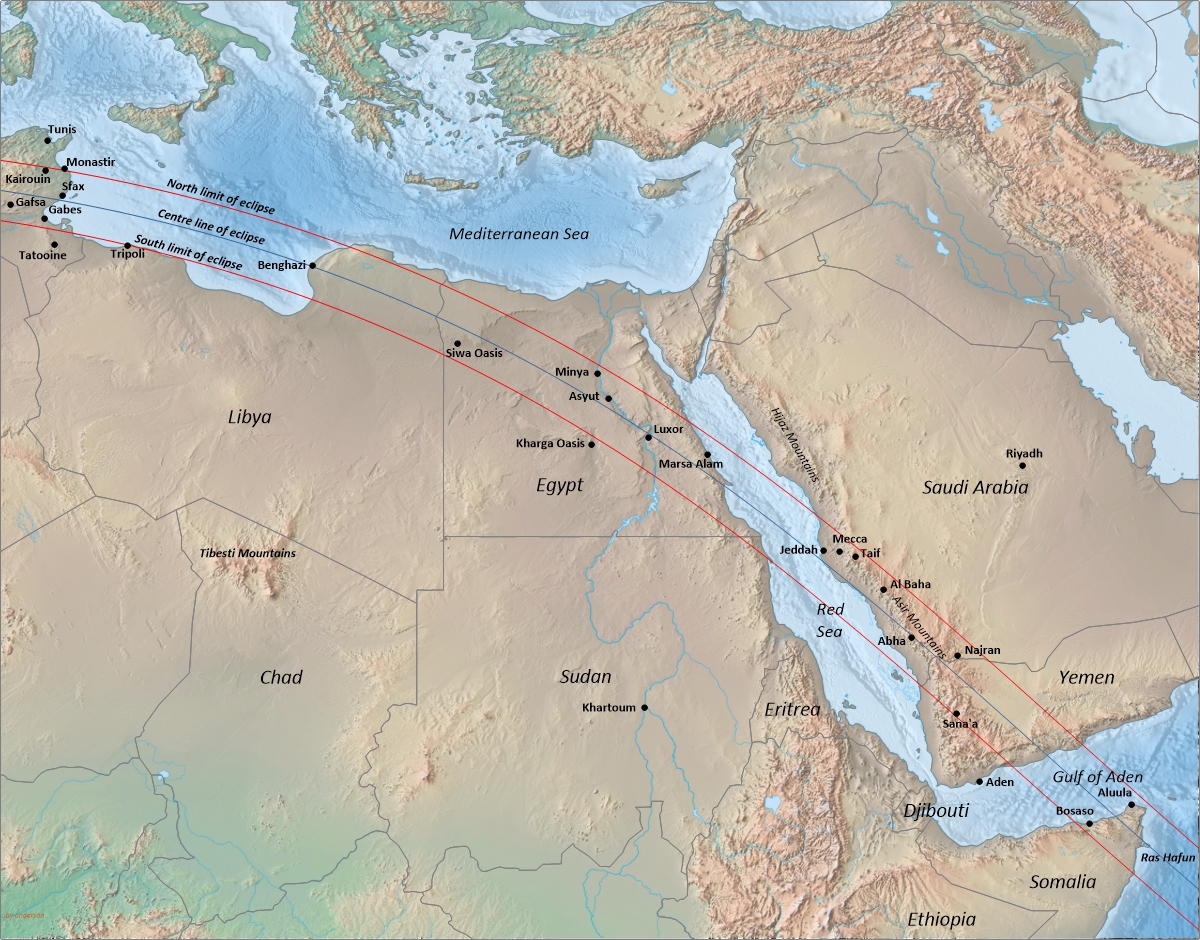
Figure 11 shows the map of average August cloud cover and the graph in Figure 12 gives more detail of the satellite-measured cloudiness along the centreline. There is no benefit in showing the cloud cover at the north and south limits as conditions don’t change much across the shadow as long as it is over the desert.
While it’s not obvious in Figure 12’s graph, the region from Luxor southeastward begins to feel the impact of the eclipse track’s southward turn into more humid climates. Most of the cloud encountered from Luxor southward to the Red Sea comes from high-level moisture drifting northward from the Sahel region over Ethiopia, southern Sudan, and Eritrea. At the same time, there is the occasional development of small cumulus clouds here and there, but these buildups should fade away quickly with the large drop in temperature that will come with the approaching shadow. For the most part, cloud seldom seems to stray south of Aswan, but it’s a threat to Luxor, though a small one.
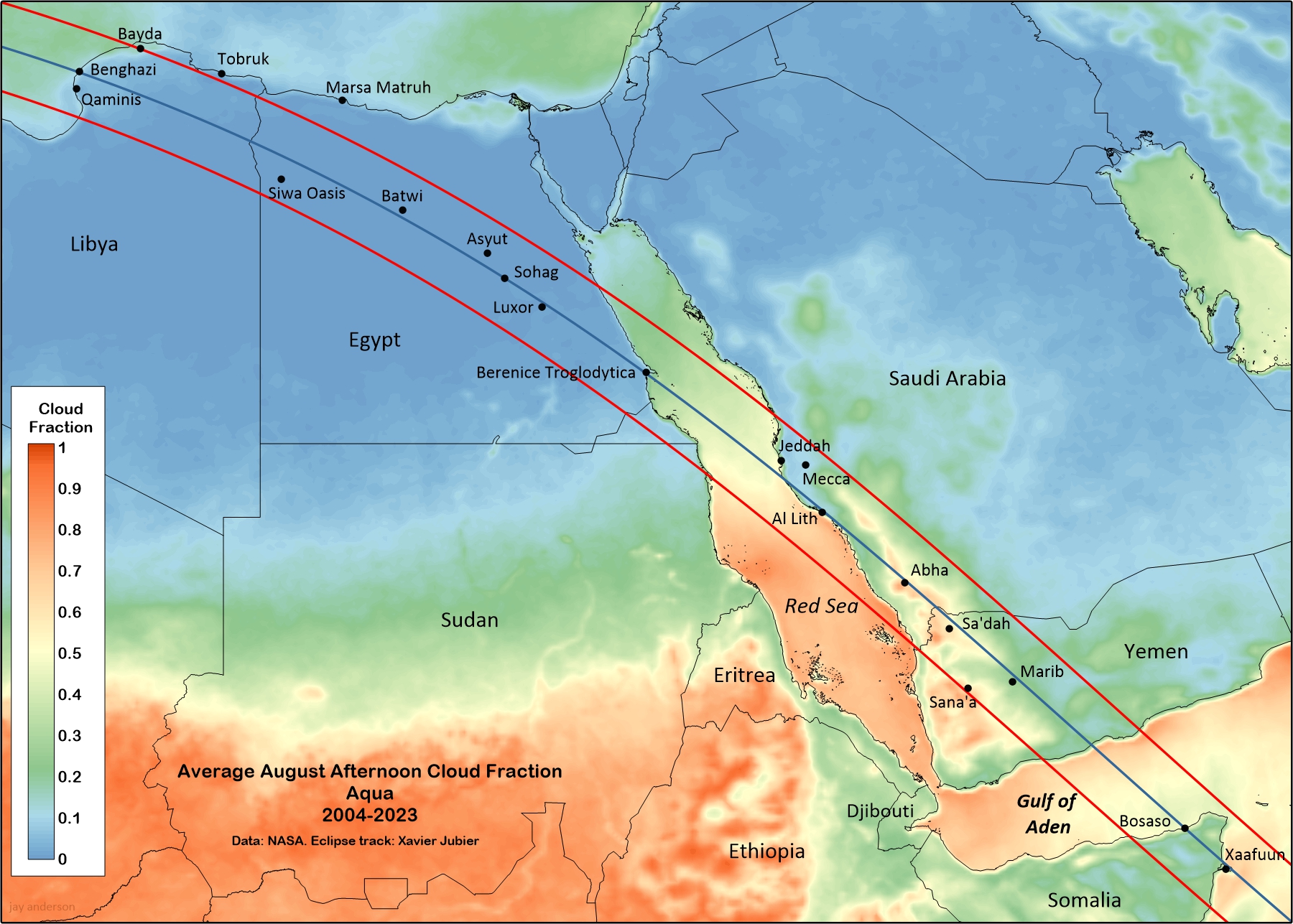
Dust is only an occasional problem in Luxor, even though it’s close to where the AOD concentration in Figure 8 begins to climb. In scrutinizing the satellite images for the graph in Figure 9, I noted that though there were often heavy dust concentrations over southeast Egypt, those storms usually retreated well before reaching the city. Given Luxor’s proximity to the Arabian Deserts and to the Sahara, it’s not unusual for even heavy dust storms to come by on occasion, but August seems to be spared the worst of them.

The Arabian Peninsula and beyond
Beyond Egypt, both cloud and dust begin to increase. In particular, there is over a 40 percent rise in average cloudiness between Berenice Troglodytica and Jeddah, on the opposite sides of the Red Sea. Some of this increase in cloud cover across the Red Sea may be an artifact of the cloud detection algorithms since the cloud contours outline the Red Sea so closely, but inspection of the daily satellite images shows that much of it is real. Once the shadow path reaches Saudi Arabia, cloud climbs more quickly (Figure 11), but this is mostly over the Hijaz Mountains and so it is not surprising that the Tihamah Plain along the coast is relatively sunny with August’s average cloud cover just over 10 percent. It’s a small area, and so most of the other Saudi and Yemeni sites have sunshine percentages in the 60s. Cloudiness declines again as the track leaves the mountains and reaches Marib, where the dryness of the Arabian Desert begins to be felt. After crossing the Gulf of Aden, the eclipse shadow crosses the tip of the Horn of Africa and heads into the cloudy Indian Ocean for one final island stop—the Chagos Archipelago, where you aren’t allowed to go.

The greatest problem for otherwise suitable sites in Saudi Arabia is dust, as the region is sandwiched between the Arabian Desert on one side and the Sahara on the other. As a result, the Tihamah Plain has by far the highest average AOD along the track in Figure 8 and in Figure 9, Jeddah stands out with its high frequency of dusty skies. For the eclipse seeker on the Arabian Peninsula, dust and cloud will both be ongoing concerns.
Over Yemen, near Marib, where the eclipse track emerges from the mountain terrain, cloudiness falls to around 20 percent in Figure 12 . In Somalia, the interior is protected from the Gulf cloud by the 2,400-m Ogo Mountains. Bosaso, on the coast, has an average August cloudiness of 50 percent (Figure 12), but this drops sharply to under 20 percent on the south side of the mountains where desert conditions prevail. August is the driest month on the Horn of Africa but the Ogo Mountains are high enough to catch a part of the Indian Ocean moisture and enjoy a wetter August from a few convective clouds.
The final stop for the lunar shadow is the Chagos Archipelago, a group of seven atolls in the Indian Ocean, that is formally known as the British Indian Ocean Territory. The northern portion of the Archipelago lies under the eclipse track but the only inhabited atoll is the island of Diego Garcia, the site of a joint British-U.S. military base that lies 130 km outside the south limit. It’s treated as a high-security base and access is presently extremely limited in spite of the recent agreement to return the atoll to Mauritius. The average cloud fraction for Diego Garcia is considerably at odds with the claimed 80 percent sunshine but in line with the average monthly precipitation in Table 3.

In retrospect
Cloud cover for this eclipse is among the lowest I’ve analyzed over the last 45 years and it’s easy to lose sight of that when the detailed minutia are inspected up close. Just about anywhere will present a good to excellent opportunity to see this event and bathe in over 6 minutes of totality. Dust is a threat in most areas, but only an occasional serious problem. If you want a guarantee, I’d suggest Siwa Oasis or the Bahariya Oasis (Batwi), both in Egypt, which have almost no prospect of cloud and seem to be relatively immune from dust storms. Benghazi similarly looks like a very good site.
Published November 1, 2024
